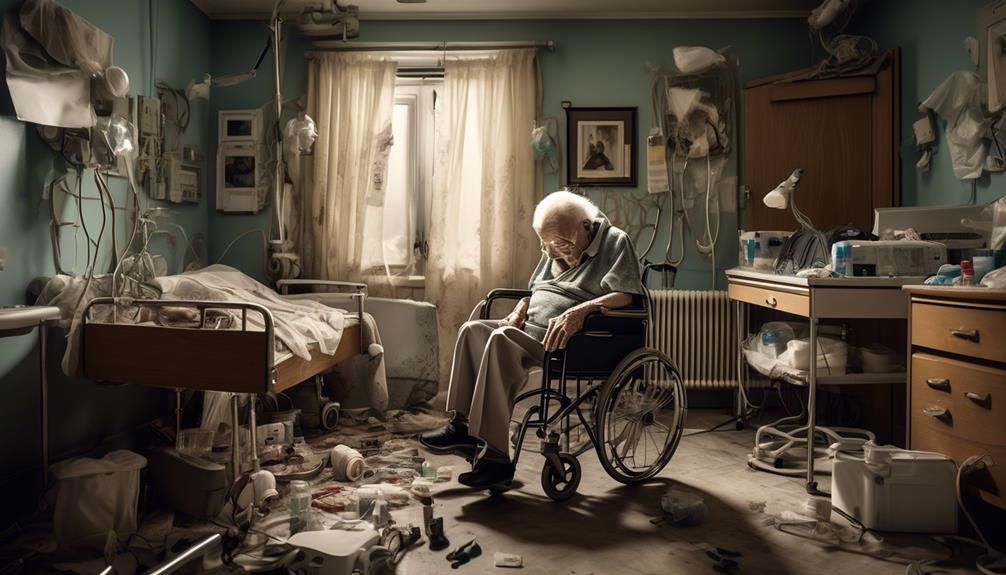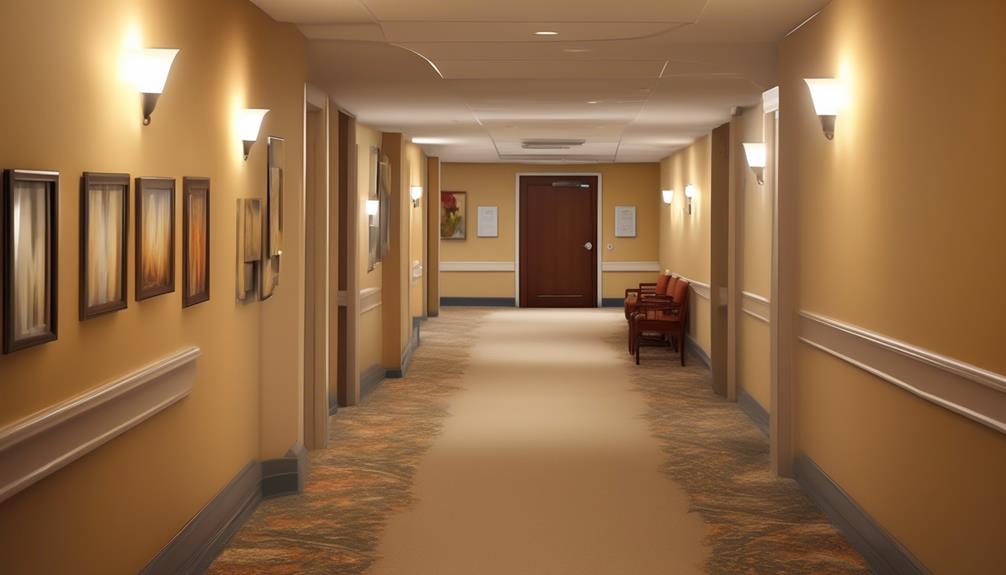While some people may think that assisted living facilities provide crucial support for senior citizens, our investigation reveals a troubling reality lurking behind the glossy brochures and inviting facades.
The facade of safety and comfort often masks a landscape rife with dangers, deceit, and dysfunction that put vulnerable residents at risk.
As we delve into the intricacies of this industry, prepare to have your assumptions challenged and your eyes opened to the hidden truths that demand our attention.
Key Takeaways
- Understaffing leads to compromised care quality.
- Deceptive marketing erodes trust in facility services.
- Legal challenges highlight negligence risks.
- Industry reform crucial for resident well-being.
Hidden Dangers of Assisted Living
Hidden dangers lurk within many assisted living facilities, posing serious risks to residents' well-being and safety. The assisted living industry is meant to provide a supportive environment for individuals with varying health care needs. However, inadequate staffing ratios and lack of properly trained staff can compromise the level of care residents receive. This shortfall in care puts residents at risk of not having their health needs met in a timely and appropriate manner, leading to potential harm.
For residents and family members, it's essential to be aware of the potential dangers present in some assisted living facilities. From financial exploitation to dysfunctional environments resulting from deceptive marketing practices, there are various challenges that residents may face. It's crucial for families to advocate for better regulations and oversight within the industry to ensure the safety and well-being of their loved ones. By understanding these hidden dangers, families can make informed decisions when selecting an assisted living facility and work towards improving the overall quality of care provided.
Deceptive Marketing Tactics Exposed

Exposing the deceptive marketing tactics employed by some assisted living facilities reveals a concerning trend in the industry. It's disheartening to learn that false promises of specialized care, misleading tactics, and exaggerated claims about staff qualifications, amenities, and services are being used to lure residents. These deceptive strategies not only mislead potential residents but also erode trust in the quality of care provided.
As individuals seeking to serve others, it's imperative for us to research and verify the information presented by assisted living facilities. By scrutinizing the accuracy of the details provided, we can protect ourselves and our loved ones from falling prey to misleading marketing practices. Ensuring that the care and services promised align with the reality experienced is crucial in making informed decisions about assisted living options.
Let's remain vigilant and advocate for transparency in marketing to uphold the well-being and dignity of residents.
Impact of Understaffing on Residents
Having uncovered the deceptive marketing tactics used by some assisted living facilities, we now turn our attention to the critical issue of the impact of understaffing on residents.
Residents in understaffed facilities may face delayed response times for their care needs.
Inadequate supervision due to understaffing can jeopardize the well-being of residents with complex medical conditions.
Neglect and compromised safety are prevalent consequences of understaffing in assisted living facilities.
Understaffing contributes to a higher likelihood of medication errors and insufficient monitoring of residents' health status.
The lack of ample staff can lead to residents feeling isolated and unsupported in their daily care requirements.
It is essential to address the repercussions of understaffing in assisted living facilities to ensure the safety, well-being, and quality of life for all residents. By acknowledging and rectifying these staffing challenges, we can create environments that prioritize the dignity and care of those who call these facilities home.
The Truth About Assisted Living Neglect

In addressing the issue of assisted living neglect, we must prioritize the safety and well-being of residents through proactive measures and diligent oversight. Assisted living facilities have faced legal actions due to inadequate care capabilities, resulting in wrongful death suits from resident assaults, falls, and mismanagement of conditions.
Challenges arise when residents aren't allowed to age in place, triggering acuity creep issues such as wandering, noncompliance, falls, and aggressive behavior.
To combat acuity creep, facilities must implement risk mitigation strategies like proactive care management protocols, specialized staff training, and collaboration with healthcare providers. Regular review of care plans based on resident acuity is crucial.
Engaging legal advisors to address liability concerns, establishing clear emergency protocols, and educating residents and families on care expectations are essential steps in ensuring resident safety and well-being.
Urgent Need for Industry Reform
The urgent need for industry reform in assisted living is evident through the alarming lack of regulation, prevalence of deceptive marketing tactics, and persistence of unsafe conditions. As advocates for resident safety and well-being, we recognize the critical importance of addressing these issues head-on.
- Transparency: Ensuring clear and honest communication between facilities, residents, and families.
- Quality Care: Implementing high standards of care to promote the well-being of residents.
- Accountability: Holding assisted living facilities responsible for their actions and ensuring consequences for negligence.
- Regulatory Oversight: Establishing robust regulations to govern the industry and protect residents.
- Ethical Marketing Practices: Promoting truthful advertising that accurately represents the services provided.
Frequently Asked Questions
What Is Negative About Assisted Living?
Assisted living can present challenges, such as inadequate staff training, profit-driven practices, and lack of regulations. Safety risks, deceptive billing, and confusion due to poor oversight can harm residents.
Eviction policies lacking transparency and marketing tactics that prioritize profit over well-being are also concerning. Residents and families may face difficulties navigating these issues, impacting their overall experience and well-being.
Awareness of these challenges is crucial for promoting better care and support in assisted living facilities.
What Happens When Assisted Living Is Not Enough?
When assisted living isn't enough, residents may face increased risks, health issues, and dissatisfaction.
Safety concerns, neglect, and compromised well-being can become prevalent. Without adequate care, residents may need to explore alternative options or seek higher levels of support.
Families and individuals often find themselves making tough decisions to ensure the health and safety of their loved ones. It's a challenging situation that demands careful consideration and proactive measures to address effectively.
How Often Should You Visit Your Husband in a Nursing Home?
We believe that visiting your husband in a nursing home is essential for his well-being. The frequency of visits can vary based on individual circumstances, but experts recommend visiting at least once or twice a week.
Regular visits allow you to monitor his care, advocate for his needs, and provide emotional support. Quality time spent together strengthens your relationship and helps your husband feel connected and valued.
Your presence can also help detect any issues with his care promptly.
What Are the Three Principles of Assisted Living?
We believe the three principles of assisted living are autonomy, choice, and individuality.
Autonomy empowers residents to make decisions about their daily lives and care.
Choice allows residents to select their living arrangements and services based on their preferences.
Individuality ensures personalized care plans tailored to each resident's unique needs and goals.
These principles prioritize resident independence, well-being, and dignity, aiming to enhance their quality of life.
Conclusion
In conclusion, the assisted living industry is in dire need of reform to ensure the safety and well-being of residents.
While some may argue that implementing stricter regulations will increase costs and limit choices for families, the reality is that standardized care practices and enhanced transparency are essential for protecting vulnerable individuals.
By addressing the hidden dangers, deceptive marketing tactics, and understaffing issues, we can create a more trustworthy and reliable environment for those in need of assisted living services.









